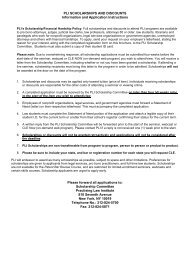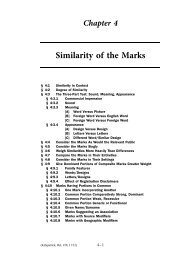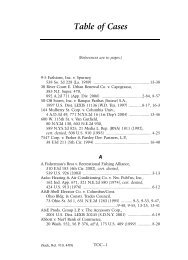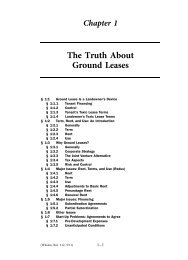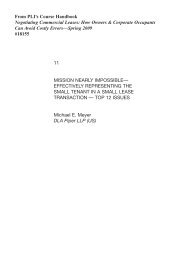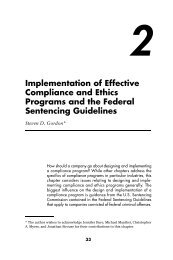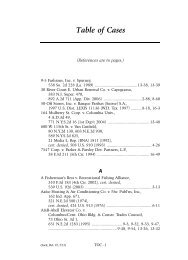i. underwriting agreements
i. underwriting agreements
i. underwriting agreements
You also want an ePaper? Increase the reach of your titles
YUMPU automatically turns print PDFs into web optimized ePapers that Google loves.
HOW TO PREPARE AN INITIAL PUBLIC OFFERING 2012<br />
I. Underwriting Agreements<br />
II. The FINRA Review Process<br />
March 1, 2012<br />
Presenter: Eileen Shin<br />
Executive Director, Assistant General Counsel
I. UNDERWRITING AGREEMENTS<br />
What is the purpose of the <strong>underwriting</strong> agreement<br />
• It documents the agreement among the parties regarding the<br />
economic and legal terms of the transaction<br />
• Nature, amount and price of the securities being sold<br />
• Type of transaction – primary, secondary or combination<br />
• Nature of the underwriters’ commitment to purchase<br />
• firm or best efforts<br />
• each underwriter’s obligation to purchase is several and not joint with the other<br />
underwriters’ obligations in order to limit each underwriter’s liability exposure<br />
• Issuer’s and/or selling shareholders’ commitment to sell<br />
• Allocation of liability among the issuer, any selling shareholders and<br />
the underwriters<br />
2
I. UNDERWRITING AGREEMENTS<br />
Parties, Form and Timing<br />
• Parties: issuer, any selling shareholders and lead bookrunners on<br />
behalf of the <strong>underwriting</strong> syndicate<br />
• Negotiation is usually not an adversarial process<br />
• Drafted by underwriters’ counsel, typically starting with the form<br />
agreement of the lead left bookrunner<br />
• Required to be filed as an exhibit to the registration statement because<br />
it is a material agreement; however, a form may be filed<br />
• Not executed until the pricing date, after the entire registration process<br />
and most of the offering process is complete<br />
• Until execution, there is no contractual arrangement between the issuer,<br />
selling shareholders and underwriters<br />
• Engagement letters negotiated at the time of mandate are not standard in the<br />
U.S. market, although occasionally signed in the IPO context<br />
3
I. UNDERWRITING AGREEMENTS<br />
Introduction, Purchase and Sale, Delivery and Payment<br />
• Introduction – sets forth the parties to the transaction, a description of the<br />
securities being sold and the number of shares being sold<br />
• May include a description of related transactions, such as an acquisition being funded by<br />
the proceeds<br />
• Purchase and Sale – sets forth the price at which the underwriters agree to buy<br />
the securities from the issuer/selling shareholders, reflecting a commission to<br />
the underwriters in the form of a discount to the public offering price<br />
• Sets forth the overallotment or “greenshoe” option<br />
• Underwriters may sell more shares than they have agreed to purchase from the issuer<br />
and/or selling shareholders in the base offering<br />
• To cover the syndicate short position in a rising market, underwriters have an option to<br />
purchase additional shares from the issuer and/or selling shareholders at the same price<br />
as shares bought in the base offering<br />
• Option is typically exercisable for 30 days after pricing by the lead bookrunners<br />
• Amount of shares in the option are limited by FINRA rules to 15% of the base offering<br />
• Delivery and Payment – sets forth settlement mechanics, typically occurring on<br />
T+3<br />
4
I. UNDERWRITING AGREEMENTS<br />
Representations and Warranties<br />
• Issuer makes representations and warranties concerning:<br />
• No material misstatement or omission in the registration statement and prospectus<br />
• Accuracy of financial statements and independence of auditors<br />
• Corporate authorizations and other representations that address the validity of the<br />
transaction and securities being offered<br />
• Various aspects of the issuer’s business, including compliance with various laws<br />
• Areas specific to the issuer’s industry or jurisdiction (if outside the United States)<br />
• Selling shareholders make representations and warranties, but the<br />
scope will depend on their relationship to the issuer<br />
• “Clean hands” representation<br />
• Often heavily negotiated among external lawyers<br />
• Negotiation of representations and warranties serves as a helpful<br />
diligence exercise and can help all parties to focus on areas of<br />
particular concern<br />
5
I. UNDERWRITING AGREEMENTS<br />
Covenants<br />
• Agreements of the issuer to maintain the accuracy of the prospectus, notify the<br />
underwriters of certain events such as a stop order or the inaccuracy of any reps<br />
and warranties, maintain a listing of the securities and refrain from activities that<br />
stabilize or manipulate the price of the securities<br />
• Lockup or “clear market” provision is by far the most negotiated covenant<br />
• Issuer agrees not to sell shares or securities convertible into shares or make any public<br />
announcement regarding such a sale, including through the filing of a registration<br />
statement, for a period of time after the offering, usually 180 days for an IPO<br />
• Issuer negotiates certain carveouts to this restriction such as issuances in connection<br />
with employee compensation plans or in connection with M&A activity<br />
• Selling shareholders may have a lockup provision in the <strong>underwriting</strong> agreement<br />
or may sign up the form of separate lockup agreement that non-selling<br />
shareholders, officers and directors sign<br />
• Underwriters covenant not to use any free writing prospectus that would create<br />
an issuer filing obligation<br />
6
I. UNDERWRITING AGREEMENTS<br />
Conditions to the Obligations of the Underwriters<br />
• Closing conditions are the conditions that need to be true or other<br />
obligations that need to be met in order for the underwriters to be<br />
obligated to purchase the securities and close the transaction<br />
• Includes documents that need to be delivered to the underwriters,<br />
such as certificates, opinions and comfort letters<br />
• Includes condition that the representations and warranties are<br />
accurate on the day of settlement and, in particular, that there be no<br />
material adverse change in the issuer’s business<br />
• If a condition is not met, the underwriters can either waive the<br />
condition or terminate the agreement and unwind trades<br />
7
I. UNDERWRITING AGREEMENTS<br />
Indemnification and Contribution<br />
• Important to the underwriters because the underwriters undertake<br />
potential statutory liability for alleged or actual misstatements or<br />
omissions in the issuer’s disclosure document<br />
• Case law has put the validity of indemnification of the underwriters in<br />
doubt, citing public policy concerns<br />
• Law firms will only opine as to the due authorization, execution and delivery<br />
of the <strong>underwriting</strong> agreement and not as to its enforceability<br />
• Generally comprised of three elements<br />
• Indemnification by issuer (and any other sellers) for claims brought against<br />
underwriters by third parties (and related expenses)<br />
• Indemnification by underwriters for claims brought against issuer by third<br />
parties (and related expenses)<br />
• Contribution<br />
8
I. UNDERWRITING AGREEMENTS<br />
Indemnification by Issuer and Other Sellers<br />
• Covered persons<br />
• Broadly defined to include underwriters and their affiliates, officers, directors,<br />
employees and controlling persons<br />
• Scope of coverage by issuer<br />
• Limited to liabilities (and expenses incurred) arising from misstatements or omissions<br />
from prospectus<br />
• Exception for misstatements or omissions in respect of information furnished by<br />
underwriters for inclusion in offering document<br />
• Scope of coverage by any other sellers (e.g., selling shareholders)<br />
• May be as broad as issuer’s indemnity (especially for parent or founder who is seller),<br />
but:<br />
• More often these days, limited to misstatements or omissions in respect of<br />
information in offering document relating specifically to seller<br />
• Obligation usually “several” vs. “joint and several”<br />
9
I. UNDERWRITING AGREEMENTS<br />
Indemnification by Underwriters<br />
• Covered persons<br />
• More narrowly defined to include issuer, its directors and its officers<br />
who sign the registration statement (and, if applicable, any other<br />
sellers)<br />
• Scope of coverage<br />
• Limited to liabilities (and expenses incurred) arising from<br />
misstatements or omissions in respect of information furnished by<br />
underwriters for inclusion in offering document<br />
• Underwriter-furnished information very limited; specifically crossreferenced<br />
to paragraphs of offering document (“blood letter”<br />
provisions)<br />
• Obligation always “several” – not joint – and proportionate to<br />
<strong>underwriting</strong> commitment<br />
10
I. UNDERWRITING AGREEMENTS<br />
Indemnification Procedures<br />
• Parallel provisions, regardless of who is the indemnifying/ indemnified<br />
party<br />
• Right of indemnifying party (but practically speaking, the issuer) to<br />
assume defense of litigation with counsel of its choice (but reasonably<br />
satisfactory to indemnified party) and to direct litigation strategy<br />
• Other procedural aspects<br />
• Indemnified party’s right to own counsel/conditions for reimbursement<br />
• Consents necessary to settle claims<br />
• The “hammer” – indemnified party can settle without indemnifying party<br />
consent, if indemnifying party fails to reimburse expenses after 30 days from<br />
written request<br />
11
I. UNDERWRITING AGREEMENTS<br />
Contribution<br />
• Provides remedy in “equity” rather than “at law” if indemnification<br />
insufficient or not available for any reason<br />
• Amount to be contributed by indemnifying party based on relative<br />
benefits of the offering to the parties<br />
• Look also to relative fault only if relative benefit not enforceable<br />
• Limits on contribution amounts<br />
• Underwriter – the gross proceeds of securities underwritten by it or,<br />
alternatively, the offering fees received by it (consistent with several<br />
vs. joint approach)<br />
12
I. UNDERWRITING AGREEMENTS<br />
Expenses and Termination<br />
• Expenses section – the issuer, and sometimes the selling shareholders,<br />
covers all expenses of the offering, other than underwriters’ expenses<br />
• Roadshow expenses are often subject to negotiation<br />
• Caps on certain expenses may be negotiated<br />
• Termination section – underwriters may terminate the <strong>underwriting</strong><br />
agreement before closing upon certain “market outs” or force majeure<br />
events<br />
• Underwriters can also terminate if there has been a material adverse<br />
change at the issuer (the “company MAC out”) or a ratings downgrade<br />
of the issuer’s debt securities<br />
• Issuer and/or selling shareholders typically agree to reimburse the<br />
underwriters’ expenses, including external counsel fees and expenses,<br />
if the underwriters terminate for reasons allowed under the agreement<br />
13
I. UNDERWRITING AGREEMENTS<br />
Miscellaneous<br />
• Defaulting Underwriter – if one of the underwriters defaults on its<br />
obligation to purchase, this section addresses how alternative<br />
arrangements may be made, when the remaining underwriters must<br />
step in to purchase their pro rata share of the defaulting underwriter’s<br />
commitment or alternatively, when the agreement may terminate<br />
• Survival – provides that the representations, warranties and<br />
indemnities survive closing or termination<br />
• “etoys” clause – makes clear that no fiduciary relationship exists<br />
between the parties and that the transaction between the issuer, any<br />
selling shareholders and the underwriters is being conducted on an<br />
arms-length basis<br />
• Additional general contractual provisions regarding notices, successors<br />
and governing law<br />
• Foreign issuers – appointment of agent for service of process, waiver<br />
of immunity, judgment currency<br />
14
I. UNDERWRITING AGREEMENTS<br />
Exhibits – Lockup Agreements<br />
• Underwriters obtain contractual <strong>agreements</strong> from officers, directors<br />
and major shareholders<br />
• Time period is typically the same as for the company and selling<br />
shareholders (180 days in an IPO)<br />
• Typically negotiated in tandem with the <strong>underwriting</strong> agreement<br />
• Receipt of executed lockup <strong>agreements</strong> is a representation or condition<br />
to closing in the <strong>underwriting</strong> agreement<br />
• In an IPO, underwriters will negotiate to have them executed far in<br />
advance, usually before the marketing begins<br />
• What is the purpose<br />
• Give investors assurance that the market for the equity being issued will<br />
not have to absorb additional supply coming from those locked up<br />
• Facilitate the orderly distribution by preventing large blocks of stock<br />
being dumped in the market while the distribution is in process or in the<br />
intermediate after-market, particularly by insiders<br />
15
I. UNDERWRITING AGREEMENTS<br />
Exhibits – Lockup Agreements (cont’d)<br />
• Certain carveouts are highly negotiated while others are standard, such<br />
as:<br />
• Bona fide gifts or transfers to trusts for the benefit of the lockup signee or<br />
his/her family<br />
• Transfers by will or intestate succession<br />
• Transfers to affiliates<br />
• Transfers to the company to satisfy the exercise price and/or tax withholding<br />
obligations upon exercise of currently outstanding stock options<br />
• Insider sales are transparent to the market due to Form 4’s/5’s being<br />
filed with the SEC<br />
• Lockup arrangements, including negotiated carveouts, will be<br />
described in the <strong>underwriting</strong> section of the prospectus<br />
16
I. UNDERWRITING AGREEMENTS<br />
Exhibits – Lockup Agreements (cont’d)<br />
• “Booster shot” extension – provides that if the company issues an<br />
earnings release or announces material news toward the end of the<br />
lockup period or anticipates that it will do so just after the lockup<br />
period expires, the lockup period will automatically extend for an<br />
additional couple of weeks<br />
• FINRA rules prohibit the underwriters of an offering from publishing<br />
research during the 15 days before or after the expiration or waiver<br />
of a lockup, with certain exceptions<br />
• By extending the lockup period, the booster shot extension allows<br />
the research departments of the participating underwriters to<br />
publish upon an earnings release or other material news<br />
announcements without violating the FINRA rule<br />
• Lead bookrunners will have the right to waive or terminate lockup<br />
restrictions<br />
17
I. UNDERWRITING AGREEMENTS<br />
Exhibits – Lockup Agreements (cont’d)<br />
• Lead bookrunners will have the right to waive or terminate lockup restrictions<br />
• Requires coordination with other syndicate members to ensure no research issues<br />
under booster shot rule<br />
• FINRA Rule 5131 – lockup <strong>agreements</strong> of officers and directors must provide<br />
that lockup restrictions also apply to any issuer-directed shares acquired by<br />
officers and directors<br />
• If any waiver is granted, the lead manager will notify the issuer at least two business<br />
days before the release and issue, or have the company issue, a press release<br />
• Exception for release solely to permit transfers without consideration where the<br />
transferee agrees in writing to be bound by the same lockup terms<br />
18
II. THE FINRA REVIEW PROCESS<br />
Exhibits – Opinions<br />
• External counsels of the issuer and the underwriters will deliver<br />
opinions and negative assurance statements on the disclosure<br />
• Counsels for any selling shareholders will also deliver a limited set of<br />
opinions<br />
• Negotiated in tandem with the <strong>underwriting</strong> agreement<br />
• If the issuer is not a New York or Delaware incorporated entity, there<br />
may be separate opinions being delivered by a local counsel or an<br />
internal general counsel at the issuer<br />
• If there is substantial disclosure regarding regulatory matters or<br />
intellectual property, there may be separate opinions delivered by<br />
special counsel on those issues<br />
19
II. THE FINRA REVIEW PROCESS<br />
Overview<br />
• The Financial Industry Regulatory Authority is the main self-regulatory<br />
organization for securities firms in the United States<br />
• All initial public offerings are subject to review by the Corporate<br />
Financing Department of FINRA<br />
• An offering may not proceed to pricing until a “no objections”<br />
clearance by FINRA is issued<br />
• Purpose of the review:<br />
• To review relationships and arrangements between the issuer and each<br />
underwriter, including <strong>underwriting</strong> compensation and all other “items of value”<br />
received or to be received by each underwriter<br />
• To determine whether the <strong>underwriting</strong> terms and conditions of the offering are<br />
fair and reasonable<br />
• To review compliance with the conflicts of interest rules under FINRA Rule 5121<br />
• FINRA review process occurs in parallel with the SEC registration and<br />
review process<br />
• Initial filing with FINRA is essentially concurrent with the initial filing of the SEC<br />
registration statement<br />
20
II. THE FINRA REVIEW PROCESS<br />
Underwriting Compensation<br />
<br />
In addition to the underwriters’ discount or commission, all “items of<br />
value” received by the underwriters and related persons “in connection<br />
with or related to the distribution of the public offering” are considered<br />
<strong>underwriting</strong> compensation, including:<br />
• Reimbursement of underwriters’ expenses, including fees and expenses of<br />
underwriters’ counsel<br />
• Finder’s fees, financial consulting and advisory fees<br />
<br />
• Rights of first refusal to participate in future financings<br />
All <strong>underwriting</strong> compensation must be disclosed in the <strong>underwriting</strong><br />
section of the prospectus<br />
21
II. THE FINRA REVIEW PROCESS<br />
Underwriting Compensation (cont’d)<br />
<br />
<br />
<br />
FINRA rules do not state a maximum amount of compensation that is<br />
considered fair and reasonable, but for initial public offerings in recent<br />
history, FINRA has expressed that the maximum should be 9%<br />
FINRA rules also prohibit a variety of other terms and arrangements<br />
considered unfair and unreasonable, such as excessively long dated “tail<br />
fee” arrangements for deals done away from an engaged underwriter<br />
In addition to the <strong>underwriting</strong> agreement, all letters of intent and<br />
engagement letters entered into between the issuer and an underwriter<br />
in the six months prior to the initial filing need to be submitted for<br />
review<br />
22
II. THE FINRA REVIEW PROCESS<br />
Lockup Requirements<br />
• If an underwriter or “related person” acquires unregistered equity<br />
securities of the issuer during the six months prior to the initial filing of<br />
the IPO, the securities must be locked up for 180 days after the<br />
effective date of the registration statement, with limited exceptions<br />
• FINRA rules regarding <strong>underwriting</strong> compensation and lockups can<br />
greatly complicate an underwriter’s ability to participate in an IPO for a<br />
company in which an affiliated private equity arm or investment<br />
management arm has made an investment<br />
• Unrealized appreciation in the investment may be imputed as<br />
underwriter compensation that, together with the <strong>underwriting</strong><br />
discount, exceeds what is considered fair and reasonable<br />
23
II. THE FINRA REVIEW PROCESS<br />
Conflicts of interest<br />
• The diligence process conducted by underwriters’ counsel through<br />
FINRA questionnaires answered by all participating underwriters also<br />
seeks to uncover any conflicts of interest that any underwriter may<br />
have with the issuer at the time of the offering<br />
• Most common circumstance giving rise to a conflict of interest is the<br />
use of proceeds to repay debt held by the underwriters or their<br />
affiliates<br />
• If a conflict of interest is deemed to exist with an underwriter, that<br />
underwriter may only participate if a “qualified independent<br />
underwriter” (QIU) has also participated in the preparation of the<br />
registration statement and prospectus, exercising usual standards of<br />
due diligence, and if prominent disclosure is included in the prospectus<br />
specifying the nature of the conflict of interest<br />
24
II. THE FINRA REVIEW PROCESS<br />
Conflicts of interest (cont’d)<br />
• Separate indemnification of the QIU for acting in that capacity will be<br />
added to the <strong>underwriting</strong> agreement<br />
• Underwriter acting as QIU must meet certain requirements:<br />
• No conflict of interest with the issuer<br />
• Served in at least three public offerings of a similar size and type in<br />
past three years<br />
• No legal/regulatory convictions or other disciplinary actions relating<br />
to violations of the anti-fraud provisions of federal or state securities<br />
laws within the past 10 years among personnel who are in a<br />
supervisory capacity with respect to due diligence<br />
25




